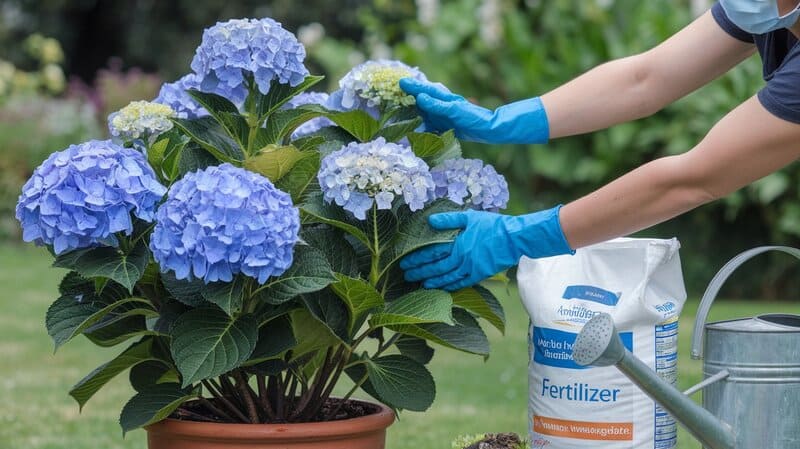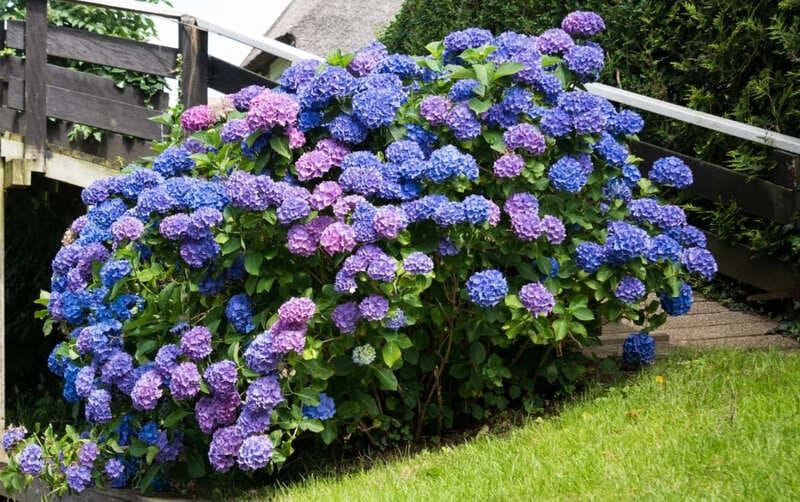
Hydrangeas are loved by gardeners due to their beautiful and firm looking flowers and abundance of types. There are over 75 species of these perennials; they can giver an entirely new look making them suitable for cottage to modern gardens.
They can grow in different climates and their flowers are built to be different to appeal all individuals. Here you will find detailed tips on how to grow and care for your hydrangeas so they can last and bloom for years.
Best Varieties of Hydrangeas for Your Garden :
It is therefore important that the right variety of these flowers is chosen to make the garden hydrangeas beautiful. Here’s a detailed look at some of the most popular types:
· Hydrangea macrophylla (Bigleaf):
They bear large, roundish shaped flowers grouped together in blue, pink or white colors on the basis of soil acidity. It grows well in subtropical regions and can be found at a location that receives slightly dappled sunlight. It is possible for varieties such as ‘Endless Summer’ to bloom for the next consecutive summer.
· Hydrangea paniculata (Panicle):
These are among the most tolerant of hydrangeas, coming with cone shaped flowers that bloom white all ages but turn pink as they grow older. They’re suitable for cold areas, and can handle sunlight fully, hence flexible for any landscape. “Some of the most commonly grown forms include Limelight and Pinky Winky.”
· Hydrangea arborescens (Smooth):
Also characterized by soft and fluffy like flowers, this strain is remarkably hardy. Annabelle is an Excellence type that produces large white flower heads that can grow up to 12 inches in diameter and would be great as a center piece in the garden.
· Hydrangea quercifolia (Oakleaf):
This variety is different from other varieties of corn with lobed leaves looking like oak trees and fall colors. The flowering part of the plant has creamy white flowers which turn pink later and share an excellent color combination with the leaves. It will grow in any degree of shade in south gardens preferring partial shade.
How to Plant Hydrangeas for Optimal Growth :

Like all plants hydrangeas require proper planting procedures for them to thrive well and establish themselves. Here’s a step-by-step guide:
1. Choose the Right Time:
Hydrangeas are best planted in early spring or fall since roots form well before hot weather sets in.
2. Select an Ideal Location:
It is recommended to select the location which has a shade to full sun, based on the type of tomato plant. A type that receives morning sunshine but afternoon shade is usually favorable for most types.
3. Prepare the Soil:
This plant grows best where the soil is well drained with good fertility. In addition, test the pH; the appropriate level is between 5.5 and 7. If that is the case then needed you may have wanted to apply organic matter such as compost to the soil to ensure it gains fertility and has a good drainage system.
4. Dig the Hole:
Dig out a pit whose width is twice the size of the root ball and the same for the depth. It also results to root systems to spread out.
5. Planting:
Next, put the hydrangea in the hole in a way that the top of the root ball is on the ground level. After that, fill with soil and water the container sufficiently in order to exclude air in it.
6. Mulching:
Spread mulch around the base to offer protection from drought and weed infestation. Organic mulch, including wood chips, or wood bark, is ideal for the job.
Watering and Fertilizing Hydrangeas :
It is very important for the plants to be watered evenly because they grow best in ample but constant supply of water. Here’s how to manage watering and fertilization:
· Hydrangeas Watering:
Ideally, let the plants have a good drink once a week, particularly when the climate dries up. Check the soil moisture because hydrangeas require evenly moist soil. For instance if the leaves droop, this is a sign they need to be watered.
·Hydrangeas Fertilizing:
A slow-release, balanced fertilizer should then be applied in the early spring to support additional new growth. An all-purpose fertilizer such as 10-10-10 or a flowering shrub fertilizer will be ideal for use on the plant. Do not provide too much fertilizer to your plant for its foliage tends to grow at the expense of flowers.

Pruning Tips for Healthy Hydrangeas :
The process of pruning is used frequently when dealing with hydrangeas in order to maintain their health and shape. Here are some tips based on the type of hydrangea :
· Bigleaf Hydrangeas:
They bloom on old wood so prune right after they’ve flowered for the season. Pinch off the plant’s dead or weak stems and manage the plant by cutting back to green tips.
· Panicle and Smooth Hydrangeas:
These bloom only on new growths, so it’s best to prune this plant in the winter just before new shoots appear. This fosters excellent flowering.
· Technique:
Always sharpen the pruners before pruning to have clean cuts. This is undesirable, so always make an effort to achieve a balanced silhouette by pruning intersecting branches to enhance air movement.
Common Pests and Diseases Affecting Hydrangeas :
There are various pests and diseases which affect hydrangeas. Here’s how to identify and manage them:
Pests:
- 1 Aphids:
These are tiny insects that feed on the surface of leaves, and when they do this they cause leaves to wilt and turn yellow in color. House plants should be checked often; spots showing signs of infestation should be treated using insecticidal soap or neem oil.
- 2 Spider Mites:
It is a very small insect that prefers dry conditions and forms webbing on plant leaves. Raise relative humidity around plants to discourage them and apply a miticide if they are found on plants.
Diseases:
- 1 Powdery Mildew:
This is a common fungal disease that affects the leaves by coat them with a white powder. To control it, make sure to have good air flow and do not water foliage overhead.
- 2. Root Rot:
A common issue that may be attributed to overwatered plants, root rot hails many negative impacts on plants. Make sure proper drainage is provided and water the plants just enough to encourage the soil to dry a little bit.
How to Change the Color of Hydrangea Blooms :
I also find it rather fascinating with hydrangeas and especially with Bigleaf Hydrangeas in that the color of the blooms varies with the pH of the soil. Here’s how to manipulate bloom colors:
· For Blue Blooms:
Try to achieve penetration of the soil acidity level that is 5.5 and below. To increase acidity one can introduce aluminum sulfate into the soil, or one may add organic matter such as pine needles, to the soil.
· For Pink Blooms:
To get pink flowers, work the soil pH up to 6.5 or higher, add lime. Be patient since it may take a season before you note a difference in the colors.
· Experiment:
You can use numerous methods to get the right color of soil, so go ahead and try varieties of soil amendments. Document your findings in a notebook as to which treatment type causes shifts in bloom color.
Best Locations for Growing Hydrangeas :

That is, it is extremely critical where to place your hydrangeas if you prayer for these plants to grow healthy and stunning. Consider these factors:
. Sunlight:
If it is hot most hydrangeas do well in an area that receives partial shade during a part of the day. Exposure to intense sun results in scorched leaves and less exposure to sun decreases flowering.
· Soil Drainage:
The number one thing to look out for is drainage of the soil in the region which should be excellent so that root rot does not occur. If you need to plant in heavy clay it’s prudent to grow in raised beds or incorporate lots of sand and organic matter into the soil.
· Protection from Wind:
If you have deciding on where to plant your hydrangeas choose an area close to a structure or a tall shrub or tree that will provide shelter from strong winds, which can ruin the flowers as well as the foliage.
How to Propagate Hydrangeas :
It can be worthwhile to learn how to propagate hydrangeas because the flowers are beautiful and easy to grow. Here’s how to do it effectively:
- · Cuttings:
During May-June, collect stem tip cuttings, each from 4-6 inches of healthy growth. Cut off the lower leaves and then place the trim below the rooting hormone solution.
- · Rooting Medium:
This media can be prepared by combining peat with perlite for growing cuttings with roots. Be Sure to Keep the Medium Moist and Place the Cuttings in Warm and Humid Condition as in Mini Green House.
- · Care for Cuttings:
Humidity must be kept high by giving a mist occasionally. It takes approximately 4-6 weeks for roots to develop in the cuttings so start assessing by pulling the cuttings lightly.
- · Transplanting:
After roots have developed, transplant cuttings into larger pots or directly into your landscape, according to the planting recommendations listed above.

Seasonal Care for Hydrangeas :
Each season brings unique care requirements for hydrangeas:
· Spring:
When the last frost is done apply slow release fertilizer and trim the plants if needed. Despite having a source of water, regular monitoring of pests and diseases is needed at this time as new growth starts to appear.
· Summer:
Stay alert for symptoms of heat stress during hot weather. Water is needed often and in large amounts; also remove faded flowers to promote new blooms.
· Fall:
After or right before flowers wither, light pruning must be done to shape the plant. As for the rest of winter, place mulch around the base to protect the plant’s roots from freezing.
. Winter:
In the regions that experience very low temperatures, you should cover the hydrangeas by burlap or put a layer of mulch on the plants. Do not prune too hard during late fall in order to avoid common winter damages.
"This content is useful - share it on social media!"

